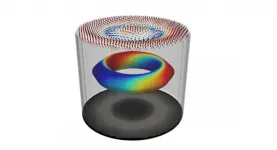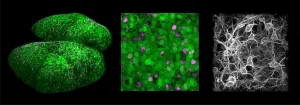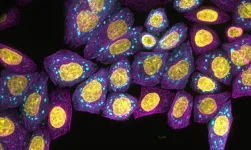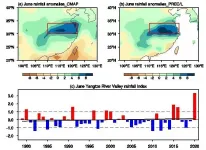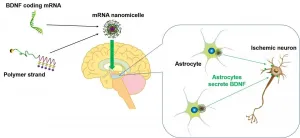(Press-News.org) It may be possible in the future to use information technology where electron spin is used to store, process and transfer information in quantum computers. It has long been the goal of scientists to be able to use spin-based quantum information technology at room temperature. A team of researchers from Sweden, Finland and Japan have now constructed a semiconductor component in which information can be efficiently exchanged between electron spin and light at room temperature and above. The new method is described in an article published in Nature Photonics.
It is well known that electrons have a negative charge, and they also have another property, namely spin. The latter may prove instrumental in the advance of information technology. To put it simply, we can imagine the electron rotating around its own axis, similar to the way in which the Earth rotates around its own axis. Spintronics - a promising candidate for future information technology - uses this quantum property of electrons to store, process and transfer information. This brings important benefits, such as higher speed and lower energy consumption than traditional electronics.
Developments in spintronics in recent decades have been based on the use of metals, and these have been highly significant for the possibility of storing large amounts of data. There would, however, be several advantages in using spintronics based on semiconductors, in the same way that semiconductors form the backbone of today's electronics and photonics.
"One important advantage of spintronics based on semiconductors is the possibility to convert the information that is represented by the spin state and transfer it to light, and vice versa. The technology is known as opto-spintronics. It would make it possible to integrate information processing and storage based on spin with information transfer through light", says Weimin Chen, professor at Linköping University, Sweden, who led the project.
As electronics used today operates at room temperature and above, a serious problem in the development of spintronics has been that electrons tend to switch and randomise their direction of spin when the temperature rises. This means that the information coded by the electron spin states is lost or becomes ambiguous. It is thus a necessary condition for the development of semiconductor-based spintronics that we can orient essentially all electrons to the same spin state and maintain it, in other words that they are spin polarised, at room temperature and higher temperatures. Previous research has achieved a highest electron spin polarisation of around 60% at room temperature, untenable for large-scale practical applications.
Researchers at Linköping University, Tampere University and Hokkaido University have now achieved an electron spin polarisation at room temperature greater than 90%. The spin polarisation remains at a high level even up to 110 °C. This technological advance, which is described in Nature Photonics, is based on an opto-spintronic nanostructure that the researchers have constructed from layers of different semiconductor materials. It contains nanoscale regions called quantum dots. Each quantum dot is around 10,000 times smaller than the thickness of a human hair. When a spin polarised electron impinges on a quantum dot, it emits light - to be more precise, it emits a single photon with a state (angular momentum) determined by the electron spin. Thus, quantum dots are considered to have a great potential as an interface to transfer information between electron spin and light, as will be necessary in spintronics, photonics and quantum computing. In the newly published study, the scientists show that it is possible to use an adjacent spin filter to control the electron spin of the quantum dots remotely, and at room temperature.
The quantum dots are made from indium arsenide (InAs), and a layer of gallium nitrogen arsenide (GaNAs) functions as a filter of spin. A layer of gallium arsenide (GaAs) is sandwiched between them. Similar structures are already being used in optoelectronic technology based on gallium arsenide, and the researchers believe that this can make it easier to integrate spintronics with existing electronic and photonic components.
"We are very happy that our long-term efforts to increase the expertise required to fabricate highly-controlled N-containing semiconductors is defining a new frontier in spintronics. So far, we have had a good level of success when using such materials for optoelectronics devices, most recently in high-efficiency solar-cells and laser diodes. Now we are looking forward to continuing this work and to unite photonics and spintronics, using a common platform for light-based and spin-based quantum technology", says Professor Mircea Guina, head of the research team at Tampere University in Finland.
INFORMATION:
Financial support for the research has been granted by, among other bodies, the Swedish Research Council, the Swedish Foundation for International Cooperation in Research and Higher Education (STINT), the Swedish Government Strategic Research Area in Materials Science on Functional Materials at Linköping University, the European Research Council ERC, the Academy of Finland, and the Japan Society for the Promotion of Science.
The article: "Room-temperature electron spin polarization exceeding 90% in an opto-spintronic semiconductor nanostructure via remote spin filtering", Yuqing Huang, Ville Polojärvi, Satoshi Hiura, Pontus Höjer, Arto Aho, Riku Isoaho, Teemu Hakkarainen, Mircea Guina, Shino Sato, Junichi Takayama, Akihiro Murayama, Irina A. Buyanova and Weimin M. Chen, (2021), Nature Photonics, published online on 8 April 2021, doi: 10.1038/s41566-021-00786-y
https://dx.doi.org/10.1038/s41566-021-00786-y
The millions of people who have chronic sinusitis deal not only with stuffy noses and headaches, they also commonly struggle to focus, and experience depression and other symptoms that implicate the brain's involvement in their illness.
New research links sinus inflammation with alterations in brain activity, specifically with the neural networks that modulate cognition, introspection and response to external stimuli.
The paper was published today in JAMA Otolaryngology-Head & Neck Surgery.
"This is the first study that links chronic sinus inflammation with a neurobiological ...
Expressive language sampling (ELS) is a useful tool for measuring communication development in youth with Down syndrome, a END ...
Cyberbullying already accounts for one in four cases of bullying and, according to the latest UNICEF report issued on the occasion of 'Safer Internet Day', it affects at least two students per class in Spanish schools.
In this regard, the Laboratory of Studies on Coexistence and Violence Prevention at the University of Cordoba, under the direction of professors Rosario Ortega-Ruiz and Eva M. Romera, has just published a study examining family communication and its impact on cyber-gossip and the excessive use of social media-two of the main factors with the greatest influence on cyber-bullying. Their results point in the same direction: an atmosphere of trust in the family is an antidote to this type of behaviour, reducing the risk of schoolchildren engaging inproblematic ...
Calibration and validation (CAL/VAL) is a key technology for quantitative application of space-borne remote sensing data. However, the complex space environment can cause many uncertainties and degrade the calibration accuracy. In-flight calibration is always needed. The thermal emission of the Moon is stable over hundreds of years because there is no atmosphere and no significant physical or chemical change on its surface. The deep space view of the Microwave Humidity Sounder onboard NOAA-18 has viewed the Moon many times every year. Under solar illumination, the lunar surface shows stable and periodical variation in microwave brightness temperature (TB). The Moon is a potential calibration source for thermal calibration
The ...
A decade ago, the discovery of quasiparticles called magnetic skyrmions provided important new clues into how microscopic spin textures will enable spintronics, a new class of electronics that use the orientation of an electron's spin rather than its charge to encode data.
But although scientists have made big advances in this very young field, they still don't fully understand how to design spintronics materials that would allow for ultrasmall, ultrafast, low-power devices. Skyrmions may seem promising, but scientists have long treated skyrmions as merely 2D objects. Recent studies, however, have suggested that 2D skyrmions could actually be the genesis of a 3D spin pattern called hopfions. ...
In all adult vertebrates, neural stem cells can be recruited to produce new neurons in the brain. However, little is known about these so-called "activation" processes.
Scientists at the Institut Pasteur, CNRS, and Tel Aviv University working in collaboration with the École Polytechnique and INRAE have successfully performed 3D visualization and spatial and temporal distribution analysis of neural stem cell activation in the adult brain of a zebrafish vertebrate model.
Their findings demonstrate for the first time that activation events for these cells are coordinated ...
Powerful algorithms used by Netflix, Amazon and Facebook can 'predict' the biological language of cancer and neurodegenerative diseases like Alzheimer's, scientists have found.
Big data produced during decades of research was fed into a computer language model to see if artificial intelligence can make more advanced discoveries than humans.
Academics based at St John's College, University of Cambridge, found the machine-learning technology could decipher the 'biological language' of cancer, Alzheimer's, and other neurodegenerative diseases.
Their ground-breaking study has been published in the scientific journal PNAS today (April 8 2021) and could be used in the future to 'correct the grammatical mistakes inside cells that cause disease'.
Professor Tuomas Knowles, lead ...
The prevalence of SARS-CoV-2 infections in preschool and school children is an important benchmark for deciding whether to open kindergartens and schools. The screening study "Fr1da" led by Anette-Gabriele Ziegler tests children in Bavaria for an early stage of type 1 diabetes. These tests include the collection of blood samples. In response to the COVID-19 pandemic, the researchers had decided to use the valuable study infrastructure of the Fr1da study to detect SARS-CoV-2 infections, too. For this, they developed a SARS-CoV-2 antibody test with particularly high accuracy. During the first ...
The rainfall over the Yangtze River Valley (YRV) in June 2020 broke the record since 1979 (Figure 1). As of June 28, the People's Daily Online reported that there were more than 12 million people affected by flood disasters related to this torrential rain, with deaths or disappearances of 78 persons and a direct economic loss of more than 25 billion CNY. Recently, scientists from South China Sea Institute of Oceanology (SCSIO), Chinese Academy of Sciences revealed the cause of the record-breaking rainfall over the YRV.
According to their study published in Science China Earth Sciences on March 19, 2021, all three oceans of the Pacific, Indian and Atlantic Oceans ...
Researchers from Tokyo Medical and Dental University (TMDU) demonstrate an mRNA delivery system that effectively produces BDNF protein in rat brain to protect neurons from ischemia
Tokyo - A lack of oxygen to brain tissue--known as ischemia--leads to the death of neurons, which results in stroke. Despite considerable research, there are currently no treatments that successfully prevent neuronal death. Now, Tokyo Medical and Dental University (TMDU) researchers have reported a way of delivering mRNA to produce a therapeutic protein that protects neurons. Their findings, demonstrated in rats, ...

